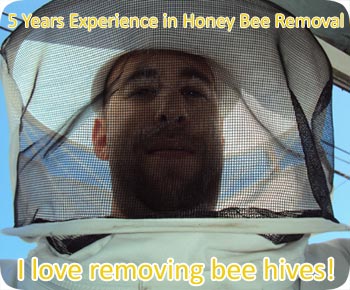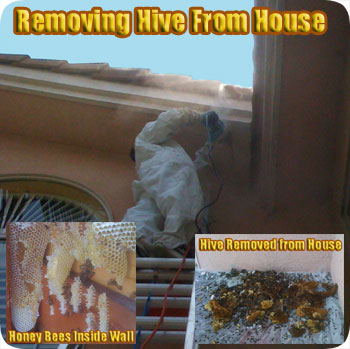
Los Angeles Bee Removal
Hello! My name
is Trevor, and I specialize in the removal of honey bee hives from homes
and other buildings. I am based in Los Angeles, California, and
service most of southern CA, including LA, San Bernardino, Riverside, and south to Santa Ana and Huntington Beach.
I operate a fully licensed and insured pest control business in the
state of California. I have the best bee removal equipment and training
available, and I have the best insurance and licensing available as well.
I have a great advantage over the large pest control firms - first of
all, I do better work than them, hands down. If you hire a big bug
company, you'll get an underpaid employee who doesn't really care of the job
is done right. If you hire me, I will arrive at your house, and do the
job correctly and professionally, from start to finish. I have 5 years
of bee removal experience, and I am available 24 hours a day, 7 days a week.
Give me a call! | |
 |
 | |
Honey Bee removal is not a trivial matter. Well, first of all, it's
important to properly identify the bee species that you have in your home or
building. Different insects require different approaches. I am
fully trained and equipped to deal with all nuisance stinging insects, but
the Honey Bee, of the genus Apis, of which there are several species,
including the Africanized Killer Bee, which has invaded California,
require special care.
You can't just use a poison control solution
when it comes to honey bees. Poison does work for several species of
insects. But Honey Bees must be removed by hand, and the entire hive
must be removed. This is why these special bee suits and equipment are
manufactured in the first place. You've got to remove the entire hive,
because a beehive may be comprised of several thousand, even tens of
thousands of bees. Not only that, they create a large network of wax
honeycombs and honey. If you don't remove the whole hive properly,
you'll have a few problems on your hands. First, new bees will find
the hive. Second and more importantly, you'll have a huge pile,
sometimes hundreds of pounds, of wax and honey and dead bees festering
inside the building, and leaking a stinky mess everywhere. |
| We are based in
Los Angeles FL. We operate 24/7, and strive for the highest level of customer service - we show up as scheduled, in clean truck and uniform, and we use the best equipment. We offer a full written guarantee on our work, and provide a full range of services for all of your bee control needs. We put a great deal of care and pride into our work, and make sure that the bee problem is gone for good. | |
 | |
Superior Bee
Removal: We have trained for years specially on bee control and hive
removal. Our experience counts a great deal when it comes to properly
understanding the species of bee, and the type of hive that you are dealing
with. My knowledge of architecture means that I am specially prepared to
properly disassemble the area in order to remove the hive in its entirety, and
fix the open area afterward. Bees can live in walls, roofs, attics,
chimneys, soffits, under decks, and several other areas. They can even
live as a swarm outside of a building, and each different area requires a
different approach in order to get the job done right. I have been known
to remove some hives as high as 60 feet off the ground! Not every bee
removal company can do that. But more importantly, not every bee removal
company is owner-operated, providing both the best level of service, and
competitive rates, below that of the big companies and their unmotivated
employees. Give me a call at 213-784-4944, and we'll
schedule an appointment. |
| We service greater LA, CA including the towns & suburbs of Encino, Van Nuys, Sherman Oaks, Studio City, Pacific Palisades, Santa Monica, Hollywood, and Beverly Hills, the Long Beach area, including Rancho Palos Verdes, Torrance, Lomita, Carson, Signal Hill, Lakewood, Hawaiian Gardens, Los Alamitos, Rossmoor, and Seal Beach the Anaheim area of LA, including the towns of Stanton, Villa Park, Orange, Placentia, Garden Grove, Cypress, Buena Park, and Fullerton. and the entire metropolitan region. We will also travel for bee removal projects in any part of the state. |

Bee Control News Clip: Safety with Bees -
Adapting to Africanized honeybees in Southern California does not mean there is reason to panic. It means we need to be educated, more aware and careful of our surroundings.
More popularly called "killer bees," the flying insect is a hybrid of one of the several honeybee subspecies. They generally appear like the more temperamental European honeybees but can only be distinguished for certain in laboratories with micrometric and DNA testing.
The substantial difference between the pollinating bees is that killer bees will attack when unprovoked. They respond rapidly and in large numbers and will pursue a threat for more than a quarter mile. They also can take over hives populated by their less-aggressive cousins, the European honeybee, so it is important when hives are detected to contact the California Department of Agriculture, especially because killer bees populate rapidly in the process of leaving their parent colony and starting a nest in a new location, which is referred to as a "swarm."
For example, the European honeybee hive will swarm once every 12 months. However, killer bees swarm as often as every six weeks and can produce a couple of separate swarms each time. If killer bees swarm more often, the likelihood of the public encountering a killer bee swarm increases significantly.
Since the first detection of five hives in Riverside and Orange counties just twenty-two years ago, an estimated 10,000 colonies have been discovered by state agriculture officials, with colonies also found in Los Angeles County.
It is important to note that honey bees are important, beneficial insects because one-third of Americans' daily diet comes from crops pollinated by honey bees. Without the pollen that honey bees transport, many plants can't produce fruits, vegetables and seeds.
So, unless a honeybee colony is in a location that is close to people, pets or farm animals, it should be left alone. Leaving the vicinity immediately is highly recommended when coming across a beehive. Whatever you do, don't disturb the hive as it could provoke an attack. The best action to take if attacked is to run away as fast as possible and keep running. Try to get inside a house, tent or car. Also, do not jump into water while being attacked. Killer bees will wait for you to come up for air and continue attacking.
Most people taking part in normal outdoor activities do not have to go to any extraordinary lengths to protect themselves, just be mentally prepared so you know where to escape killer bees, and be on the lookout for danger.
|




